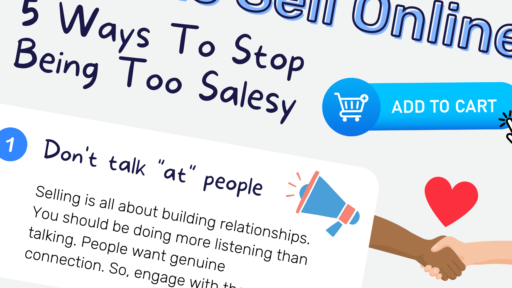So, you want to increase website traffic. Because you’ve got an awesome site that nobody sees. Or it sucks. And you want to make it less sucky.
You can spend a ton of money on a content marketing strategy. But nothing happens without effort. If not yours, someone else’s.
If you don’t have a marketing team, it’s on you. But you are really all you need. You just have to be ready to do a few things:
- The boring bits (research)
- Connect with your audience
- Create original content with a unique twist
- Help take your posts further
Content marketing can make search engines happy. Here’s how to use it to attract organic traffic:
- Make sure your site has a blog
- Make content that solves problems for backlinks
- Target low competition and long-tail keywords
- Satisfy search intent with keyword research
- Focus on your headlines
- Create a mix of evergreen and trending content
- Create an email marketing newsletter
- Design original graphics and visuals
- Topic clusters increase internal links
- Optimize content for social shares and promote
- Add your keywords in important places
- Guest post on other sites to drive traffic to yours
- Make videos, podcasts, and webinars SEO-friendly
- Build influencer relationships on social media
- Repurpose outdated content
- Use hashtags on social media to increase reach
- Encourage user-generated content
- Create a free tool
1. Make sure your site has a blog
Blogging isn’t a fad. It makes up about ⅓ of all web pages in existence. And it isn’t going anywhere.
Companies who blog produce around 67% more monthly leads. So, it’s a huge part of digital marketing.
The biggest traffic source for high-income bloggers is organic Google searches. So, SEO is super important too. (More on that later!)

Source: FounderJar
But just because everybody’s doing it…doesn’t mean they’re doing it well.
There’s no point blogging if you’re going to post any old garbage. It’s got to be high-quality. And it has to solve your target audience’s problems. Especially if you want them to stick around.
2. Make content that solves problems for backlinks
Backlinks are links to your web page from another website. They’re basically a nod of approval. It says to Google that your content is helpful.

Source: Moz
Enough of these and your Domain Rating (DR) increases. And a higher DR means you rank higher faster. Then more people will find you through Google.
But how can you make people want to link to your content? Well, you can ask them. This is a popular link-building strategy. But a lot of the time, you’ll get ignored.
You want to create content so good that people can’t help but tell others about it. And increase website traffic with barely any effort. But this only happens when you’re bringing the value. When you’re solving problems. Consistently.
But before you create this awesome content, you need to tap into your audience’s minds. If you’re psychic, great. But for the rest of us, how do we work out what our potential customers want to know?
3. Target low competition and long-tail keywords
Keywords make up the search terms people Google. And there’s a huge popularity scale for related terms. Obviously, the more people search = more potential traffic. So, you should go for the highest search volume. Right?
Wrong. If you’re trying to outrank a bigger site, you’ll have a hard time. Especially if you’re a new business owner. And the ultimate goal is being on the first SERP (search engine results page). Under paid Google ads, of course.
Low competition keywords are perfect for startups. You don’t need a high DR or a load of links to rank. And they can result in more organic traffic than you think.

So, how do you find these keywords? Well, Ahrefs Keyword Explorer is my SEO tool of choice for this. It’s a one-stop shop for keyword research.
Single keywords and brands tend to have higher difficulty. Long-tail keywords (more specific phrases) are on the other end. Users tend to search these when closer to the point of purchase. So, these can be great to try.
Just take your search term. And filter by keyword difficulty (KD). That’s how you find low-competition keywords and phrases.
4. Satisfy search intent with keyword research
Finding your search term keywords is one thing. But you need to understand the answer users are hoping to find.
That’s search intent. And a lot of marketers make the mistake of forgetting about it. They focus on what they want to write about. Rather than putting the user first.
It’s easy to work this out too. First, search your keywords. I’ve gone for “how to kickflip”.

As you can see, the first organic search results are videos. This shows that Google thinks users want to see visual tutorials. After that, the top results are written guides, tips, and tricks.
Let’s try “best wetsuits for cold water” (long-tail). Now, I get this:

Here, videos haven’t made the cut. We’re now looking at comparison blog content. Reviews and lists.
For “increase website traffic”, people want a number of ways. So, here we are.
So, you see. It’s actually super simple to work out search intent. Google your keywords and see what’s ranking highly. That’ll show the type of content with a high click-through rate. And that’s the kind you want to create.
5. Focus on your headlines
Now, you know what your searchers want to find. But how do you make sure you get that click?
Well, it starts with the first thing most people see. And sometimes the last. Because 8 out of 10 people only read headlines.
Your headline promises people their valuable time won’t be wasted. If people aren’t making it further than it, you’re screwed.

Source: Convince & Convert
If you’re trying to learn copywriting, crafting killer titles should be top priority. So, what makes an awesome one?
Well, enticing headlines should:
- Capture the essence of the content
- Make the reader feel something (shock, entertained, etc.)
- Be easily understood
- Quickly get to the point
- Include your targeted keywords
Here’s another couple examples of headlines. Both make you want to read more:

Source: Moz

Source: CopyPress
You can see why they work. So, put some time into your headline. It can even change mid-way through!
6. Create a mix of evergreen and trending content
Before crafting your headline, you’ll have an idea of the type of content you’re making. Is it an article? Video? Podcast? Make your choice. Then decide if it’s going to be trending or evergreen.
You normally see trending content on news websites. It’s relevant for a very short time. But it can cause huge spikes in web traffic because of its popularity.
Evergreen content plays the long game with search traffic. So, it’s better suited to SEO. It’s relevant now. But it’ll also continue to be for years.

Source: Ceralytics
Here are some examples of both:
| Evergreen | Trending |
| How-to tutorials | Announcements |
| Frequently asked questions | Sports predictions |
| The history of something | Breaking news |
| Glossary of terms | Upcoming events |
Your content strategy should have a mix. Find out which brings in the most traffic. Then make more of it!
7. Create an email marketing newsletter
Email is one of the oldest marketing channels. But it’s still one of the most effective. 4 out of 5 marketers would rather give up social media than email marketing. That says it all.
If you have an email list already, awesome. If you don’t, you need to start building one. And there are a few ways to do this:
- Create lots of landing pages
- Use CTAs on landing and blog pages
- Try site pop-ups
- Pitch your newsletter on your social media platforms
- Tick to join at the end of a purchase
An email newsletter can be so valuable. It can increase conversion rates. Or encourage people to keep engaging with you. You could curate a weekly roundup of content. Or one with your latest deals and promotions.
Whichever you choose, check out HubSpot’s checklist to create one:

If you want site traffic, make sure you only send your best content. Keep it visual. And think of an alluring subject line. (It’s the email version of content headlines!)
8. Design original graphics and visuals
Visual content is so important. I can’t stress that enough. It grabs people’s attention. It helps us to retain information. And I don’t mean boring stock photography. We’re gonna have to do a little better than that.
Infographics are the most liked and shared types of content on social media. And you don’t have to be a graphic designer to make your own. I’ve seen a lot of success and increase in website traffic with them:

Canva is the most popular tool. Because it’s so easy to use. It’s full of templates to inspire you. And a drag-and-drop video editor.
Apart from infographics, you can do things like:
- Design brand style guides
- Add animations to text
- Make social media header banners
- Create live video tutorials
- Put together slideshows and montages
But you can’t just make an infographic and hope people will find it. You need to use SEO writing tactics in the copy. Link to it on other blog pages. Then promote it wherever you can. Especially on social media.
9. Topic clusters increase internal links
Keyword research gives you thousands of post opportunities. But sometimes, you end up covering the same topics over and over.
Topic clusters are a newer SEO strategy. They involve focusing on pillar topics. Then a cluster of content that branches off from them. Focused on specific long-tail keywords.

Source: Semrush
The idea is that they’re all linked by the same keyword. And when one piece of content performs well, the rest do too.
Here’s a quick video that explains it:
It’s meant to help search engine crawlers connect pages. And show your authority on each subject. And as we all know, authority = higher ranking = increased web traffic.
10. Optimize content for social shares and promote
Social media marketing is used for lots of things. But mostly, it’s to spread awareness of your brand and content. And everything you post on social media counts as “content”. Yep, even your one-line replies.
Social media is overrun with content. And most of it’s pretty bad. So, yours has to stand out. For the right reasons. Sure, you could create a Facebook ad. But quality content has so much more value.
Social shares are linked to SEO. So, here’s how to create super shareable social media content:
- Make sure people will find it useful
- Include lots of visuals
- Add social share buttons to your blog
- Always be original
- Write captivating share texts
- Evoke emotions with storytelling

Source: AddThis
Next, you want to promote it. So share it on social media a few times. But not all at the same time, obviously. That’s spamming. And nobody likes spam.
Then sign up to Quuu Promote. It guarantees shares on Facebook, Twitter, and LinkedIn from people in your niche.
You can even take it further than that. Post the link on forums and community sites like Quora. But it’ll need to be part of a helpful answer. Not just a plug.
You wouldn’t believe how many people miss this last step. Content promotion. Make sure you’re not one of them.
11. Add your keywords in important places
I know we’ve covered keyword research. But this part deserves a section of its own. And it’s a quick, easy, on-page SEO hack.
So, you know the keywords you’re targeting. But there are some important places to include them. Now, SEO is constantly changing. And a lot of the time, we don’t know what works and what doesn’t.
But there are a few places most agree on:
- Your URL
- Meta title
- H1 (main headline)
- First sentence/introduction

If you can, front-load it. This basically means putting it near the start of the title. (Something I haven’t done in this blog post. But I usually try to.)
WordPress plugin Yoast also recommends adding it into your meta description too. As long as you’re not using it too much. That’s called keyword stuffing. And it’s a black-hat SEO tactic. Which means you’ll be penalized.
Focus on getting across what makes your content unique. And why people will enjoy it. Then try fitting keywords around it.
12. Guest post on other sites to drive traffic to yours
Guest blogging is popular. Because backlinks are a direct ranking factor. And guest blogging pretty much guarantees you a backlink. And increased website traffic from a new audience.
It’s how Buffer went from small business to global success. Anything that comes from outside Google counts towards your referral traffic.
Now, some sites don’t allow any type of link to the writer’s site. But weigh it up. It could still be worth getting your name out there.

Source: Blogging Wizard
So, how do you find these opportunities? Well, there are a few ways:
- Find lists that other bloggers have created
- Google search terms like “write for us” or “submit a guest post”
- Use content research tools
- Ask on social media
- Check where competitors are posting
Now, you’ve got some options. It’s down to good old outreach. But don’t just fire off the same generic email.
Automation is handy. But do your research. Personalize each message. And you’re far more likely to be successful.
13. Make videos, podcasts, and webinars SEO-friendly
Visual content is some of the most engaging online marketing. Videos are still the most popular type of content. And they’re not going anywhere. But podcasts are coming up fast behind.
By 2028, podcasting is expected to be a $94.8 billion industry. Which explains why so many people are jumping on the bandwagon now.
Interactive content is taking things to the next level. Because it needs users to involve themselves in the process. By clicking, tapping, and making decisions. And as you can imagine, it holds people’s interest for longer:
People love this kind of thing. It’s not new. But it’s not being used much right now. And novelty creates a buzz. Which can attract more people to your site.
But whatever format you choose, here’s how to make visual content SEO-friendly:
- Start with keyword research to pick your topic
- Make sure file sizes don’t affect website speed
- Add alt text so search engines can index properly
- Include a transcript
- Publish snippets on social media
SEO is constantly evolving. So, this will change over time. It could have even changed already. But it’s not going to affect anything negatively. So, add it to your content marketing strategy in the meantime.
14. Build influencer relationships on social media
Organic SEO can take a long time to increase website traffic. But there are other ways to see much faster results.
Successful influencer marketing relies on 2 things. Picking a relevant, niche market. And finding the right influencer to work with.
Now, bigger isn’t always better here. For brand awareness, someone with millions of followers might work. But nano and micro-influencers have the smallest follower counts in the influencer world. And the highest engagement rates.

Source: Later
Tools like BuzzSumo help to identify influencers in your niche. So, let’s say you’ve found a good match. How do you go about building a relationship with them?
If you have a budget, this part will be easier. If not, it’s still possible.
- Mention them in social media posts
- Send them free products or service trials
- Give them creative control
- Comment on and share their posts
- Introduce yourself at events
- Invite them to anything you host
- Ask them to take part in your podcast/webinar etc.
Now, obviously none of this guarantees you traffic. But it’s all in the selection process. If you research well, you’re giving yourself the best chance of a winning partnership.
15. Repurpose outdated content
So, you wrote a great article back in 2015. And it brought you loads of traffic. But things have moved on. And it’s taken a swift drop.
But don’t forget about it. Especially if it took a while to create. There’s life in the old dog yet!
It can take roughly 3 years to rank in the #1 spot on Google. Plus, only 5.7% of all newly published pages get to the top 10 within a year. So, don’t let your hard work go to waste.
Website visitors don’t want to be greeted with irrelevant content. So, repurposing content basically recycles it. There’s a few other benefits too:
- You get to access a whole new audience
- It’s way faster than creating brand new content
- Updating content is great for SEO
Here are some ways to repurpose older content:
- Simply update the information and stats
- Turn it into a Twitter thread
- Create a video from the content
- Turn articles into an eBook
- Make a course from multiple videos
- Post soundbites from podcasts on social media
You don’t always have to pump out new content. Show your older posts some love. You’ll give your creativity a boost. And (hopefully) your website traffic too.
16. Use hashtags on social media to increase reach
Hashtags are something a number of people get wrong. They either use too many. Or none at all. But if you’re the latter, you’re missing out on potential reach.
They’re most popular on Twitter, Instagram, and LinkedIn. And they can be used in so many ways:
- Take part in trending conversations
- Join online communities
- Create a hashtag campaign for brand awareness
- Show support for social topics
- Reveal sponsored ads or partnerships
Just make sure you stick to these tips:
- Don’t spam
- Make sure they’re relevant
- Don’t use spaces or punctuation
- Keep them short
Hashtags can take great content further. Just remember to check how popular they are before posting. There’s no point using one that nobody else is. (Unless it’s for a branded campaign!)
17. Encourage user-generated content
User-generated content (or UGC) is anything made by customers. Not brands. And it can result in serious traffic generation.
93% of marketers think that UGC performs better than branded content. Because people tend to trust it more. Professional ads show products in their best light. But user-generated photos are a real-life example.
The whole process feels more natural. Because it’s a regular person endorsing your product or service.
UGC tends to happen naturally in eCommerce. People want to show off their purchases on social media. But there are plenty of ways to encourage it too:
- Send your products to influencers for free
- Hashtag campaigns
- Feature your favorites often
- Giveaways and competitions
- Offer discounts or deals for getting involved
Including them on your site can keep users on the page for longer too. Because people want to see how products look on people that aren’t models. And a longer dwell time shows Google you’re nailing search intent.
18. Create a free tool
We all love free stuff. Especially in the world of content marketing. And people are always looking for hacks to make life easier.
Now, there are standalone tools out there. Like Title Case Converter. I use it all the time for blogging. It turns any sentence you write into title caps.

You could create a quiz or assessment. Or some kind of calculator. Just remember to include SEO writing in there to make sure it ranks.
There are also bonus tools that companies create. It’s not their main product. But they’re so valuable. They draw people in. And bring in a load of website traffic.
Tools like:
Most are free versions of premium products. But this is an awesome traffic generation method in itself. Think how you could offer something similar.
Make it as easy as possible for people to try. Maybe don’t bother with signup details. And watch them come back again and again. Then see who sticks around.
Conclusion
Content isn’t meant to fill an empty space on your site. Or appear on your social pages because you know something’s gotta be there. It’s meant to be well-planned. With a bunch of creativity and imagination added.
Most industries are fighting for a tiny slice of the market. So, you have to really earn increased website traffic. And your content is what’ll get you there.
Of course, you need to take things like site speed into account. You can have the best content anyone’s ever seen. But if it takes too long to load, you’re a goner.
Finally, don’t forget to use Google Analytics to track your metrics. You’ll be able to spot your best content. Then make more of the same!
Are there any other ways you can use content marketing to increase website traffic? Have you seen great results with any I’ve mentioned? Let me know in the comments below.





